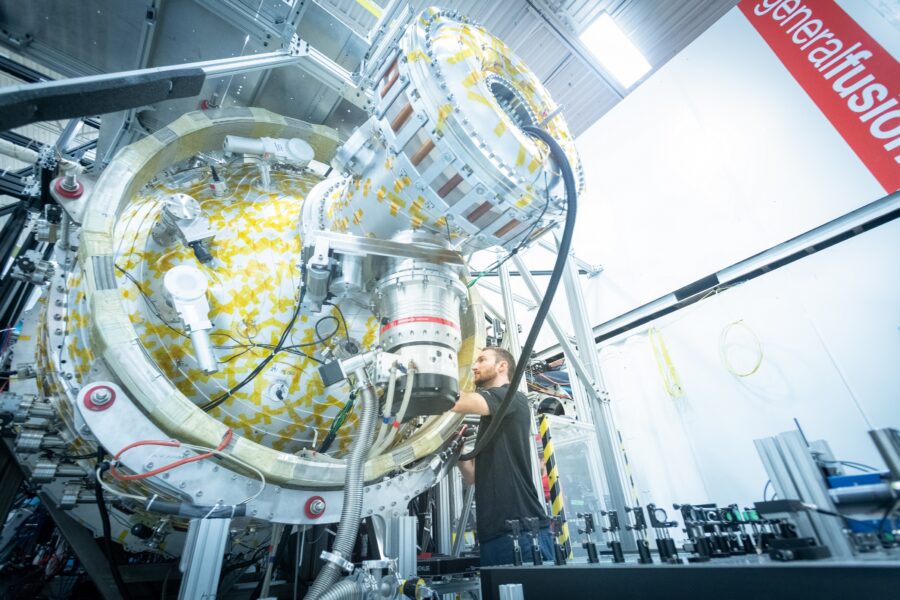 Canada’s General Fusion has announced plans to build a new Magnetised Target Fusion (MTF) machine at the company’s new Richmond headquarters. The MTF is designed to achieve fusion conditions of over 100m degrees Celsius by 2025, and to progress toward scientific breakeven by 2026. General Fusion has also completed the first round of its Series F raise for a combined $25m of funding. It was supported by existing investors, BDC Capital and GIC and also included new grant funding from the Government of British Columbia. This builds upon the Canadian government’s ongoing support through the Strategic Innovation Fund (SIF).
Canada’s General Fusion has announced plans to build a new Magnetised Target Fusion (MTF) machine at the company’s new Richmond headquarters. The MTF is designed to achieve fusion conditions of over 100m degrees Celsius by 2025, and to progress toward scientific breakeven by 2026. General Fusion has also completed the first round of its Series F raise for a combined $25m of funding. It was supported by existing investors, BDC Capital and GIC and also included new grant funding from the Government of British Columbia. This builds upon the Canadian government’s ongoing support through the Strategic Innovation Fund (SIF).
This new MTF machine, Lawson Machine 26 (LM26), aims to accelerate and de-risk General Fusion’s Demonstration Programme, designed to leverage the company’s recent technological advancements and provide electricity to the grid with commercial fusion energy by the early to mid-2030s.
LM26 is designed to be cost-efficient and produce rapid results using General Fusion’s unique approach to fusion. MTF technology is unique in the fusion market and was designed to scale for cost-efficient power plants from its inception. General Fusion says it set out to avoid the pitfalls of other approaches that require expensive superconducting magnets or high-powered lasers.
General Fusion explains that MTF “uniquely sidesteps challenges to commercialisation that other technologies face. The game-changer is a proprietary liquid metal liner in the commercial fusion machine that is mechanically compressed by high-powered pistons. This enables fusion conditions to be created in short pulses rather than creating a sustained reaction.”
LM26’s plasmas will be approximately 50% scale of a commercial fusion machine. It is designed to reach fusion conditions of over 100 million degrees Celsius (10 keV). It aims to achieve deuterium-tritium breakeven equivalent using deuterium fuel. As a result, the path to generating electricity for the grid is shorter for General Fusion than other approaches, which still need to address longstanding barriers, such as machine and material durability, fuel production, simple energy conversion, and commercial production economics.
The machine will integrate General Fusion’s existing operational plasma injector (PI3) with a new lithium liner compression system. PI3 is the culmination of 24 predecessor prototypes and over 200,000 plasma experiments. The plasma injector has already achieved the temperature and energy confinement times required by LM26. It is one of the world’s largest and most powerful operational plasma injectors, having already demonstrated plasma temperatures of 5m degrees Celsius, along with 10 millisecond self-sustaining energy confinement time. Both are critical steppingstones to achieving LM26’s target of fusion conditions in 2025 and equivalent scientific breakeven in 2026.
Over the next two to three years, General Fusion will work closely with the UK Atomic Energy Authority (UKAEA) to validate the data gathered from LM26 and incorporate it into the design of the company’s planned commercial scale demonstration in the UK.
In October 2022, General Fusion and UKAEA initiated projects to advance the commercialisation of magnetised target fusion energy as part of an important collaborative agreement. With these projects, General Fusion said it will benefit from the vast experience of the UKAEA’s team. The results will hone the design of General Fusion’s demonstration plant, which is being built at the Culham Campus in Oxford. The Fusion Demonstration Plant (FDP), a 70%-scaled version of the commercial pilot plant, will seek to prove the viability of the MTF technology. However, it will not produce power. The FDP will cycle one plasma pulse a day, and will use deuterium fuel, while the commercial pilot plant will use deuterium-tritium fuel and will cycle up to one plasma pulse per second. The FDP is expected to be commissioned in 2026 and fully operational by early 2027.
Since its establishment in 2002, General Fusion has averaged 100 neutron-generating plasmas a day. The collaboration with UKAEA, will provide access to UKAEA’s extensive neutron modelling software and expertise to simulate the neutron flux distribution from PI3 and future machines.
General Fusion CEO Greg Twinney said: “Our updated three-year Fusion Demonstration Programme puts us on the best path forward to commercialise our technology by the 2030s. We’re harnessing our team’s existing strengths right here in Canada and delivering high-value, industry-leading technical milestones in the near term.”
“Our government is committed to fighting climate change and achieving net-zero by 2050. Our support in General Fusion will help position Canada as a world leader in fusion energy technology,” said François-Phillipe Champagne, Minister of Innovation, Science & Industry.
Image: The plasma injector (PI3) has already achieved the temperature and energy confinement times required by LM26 (courtesy of General Fusion)






